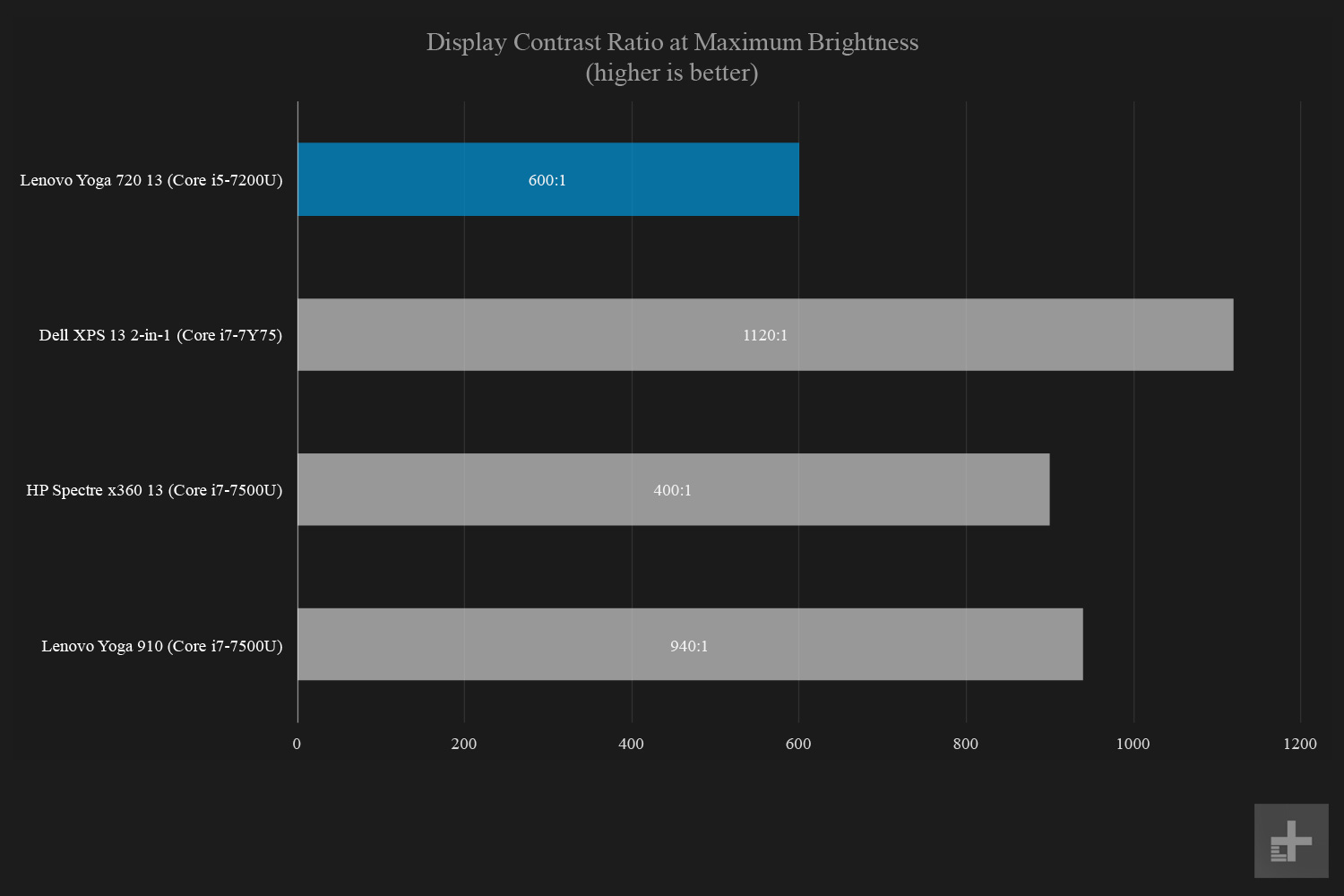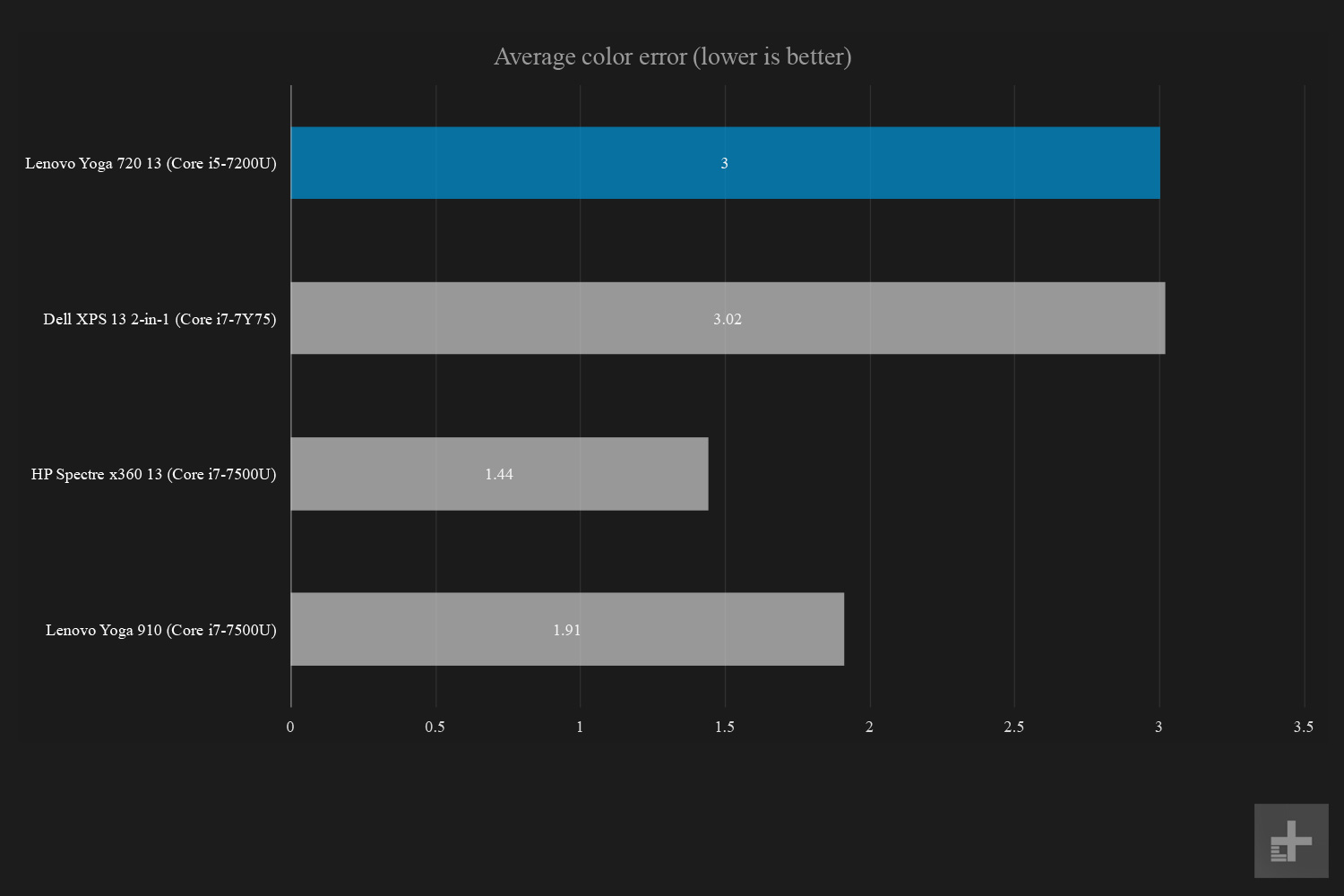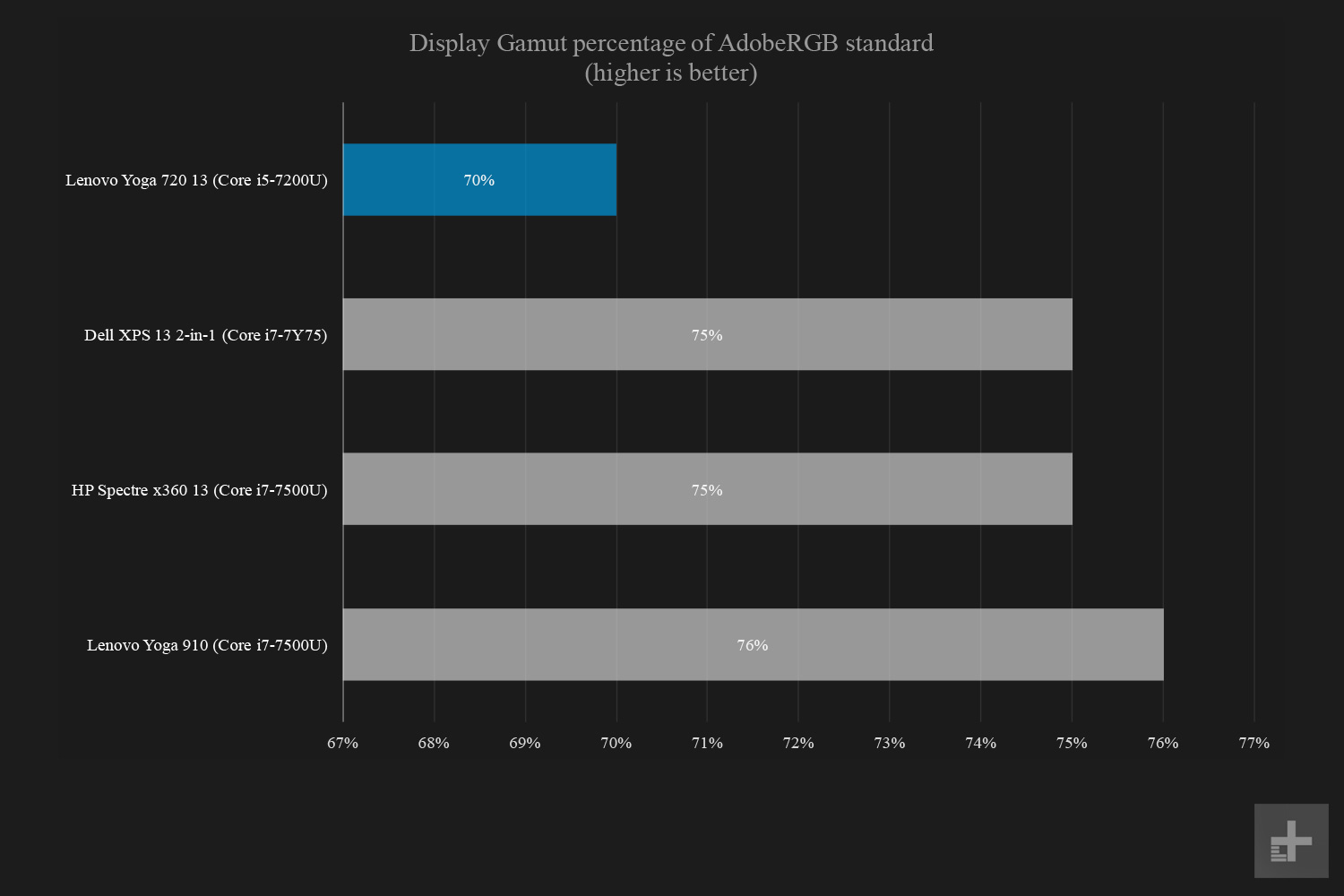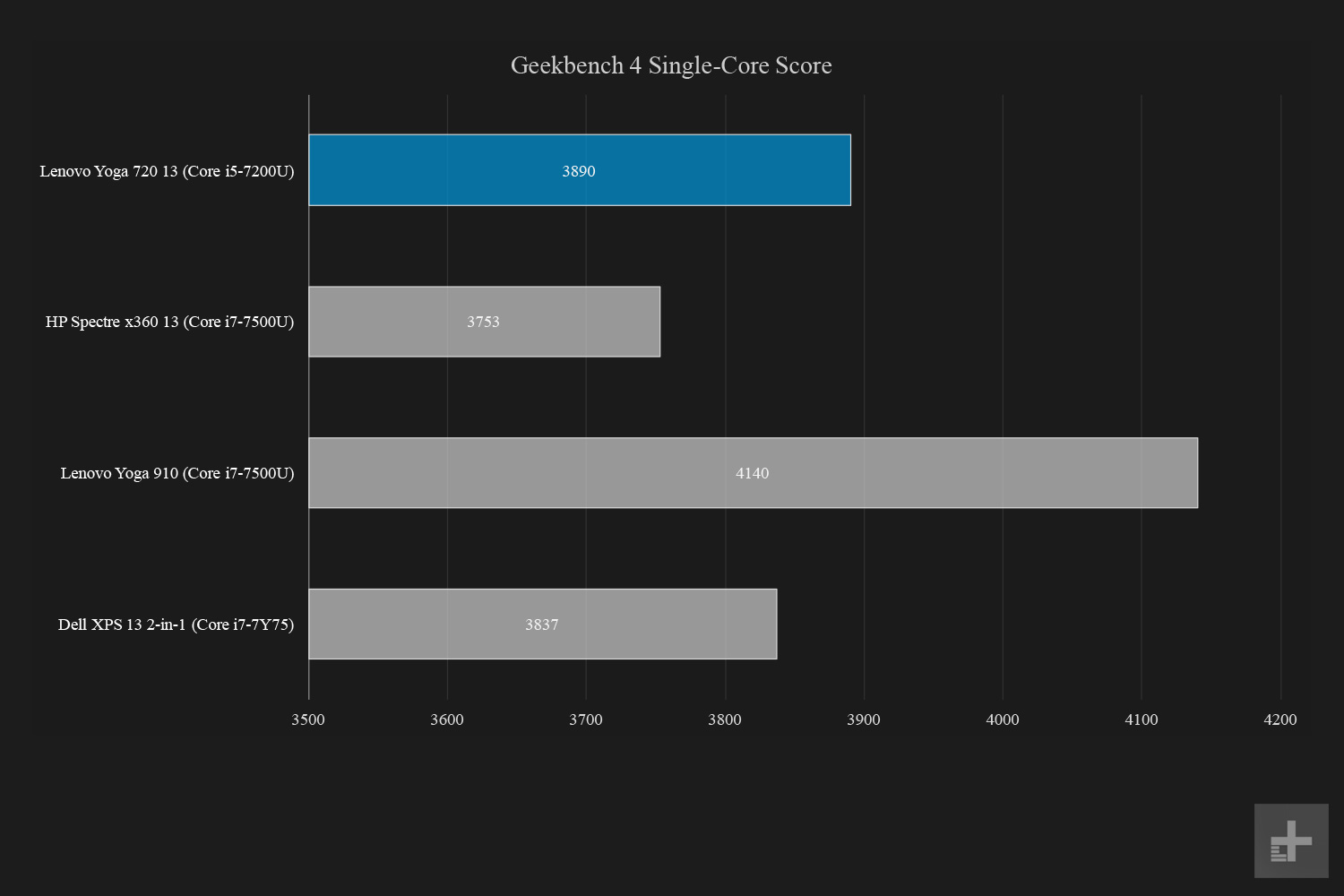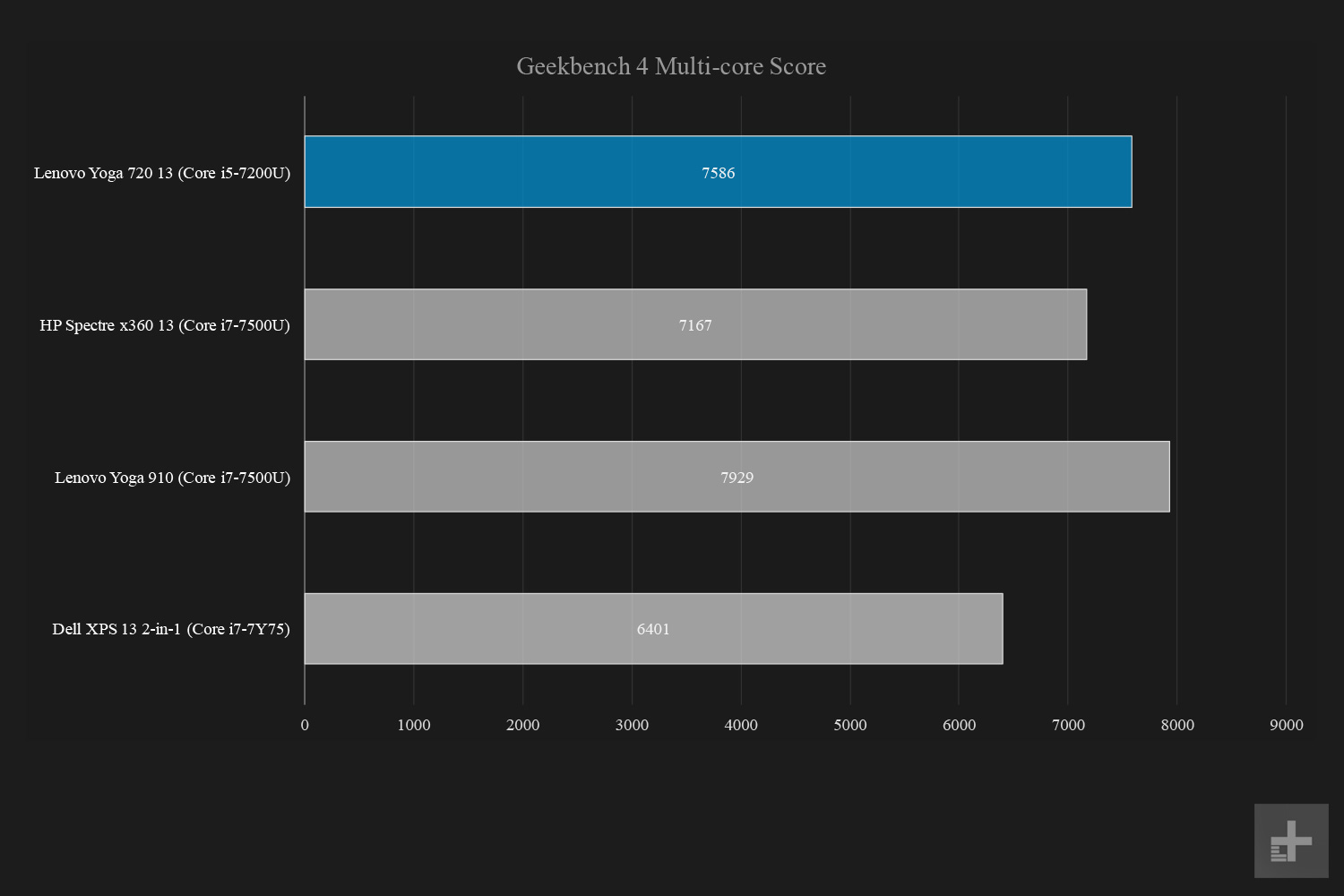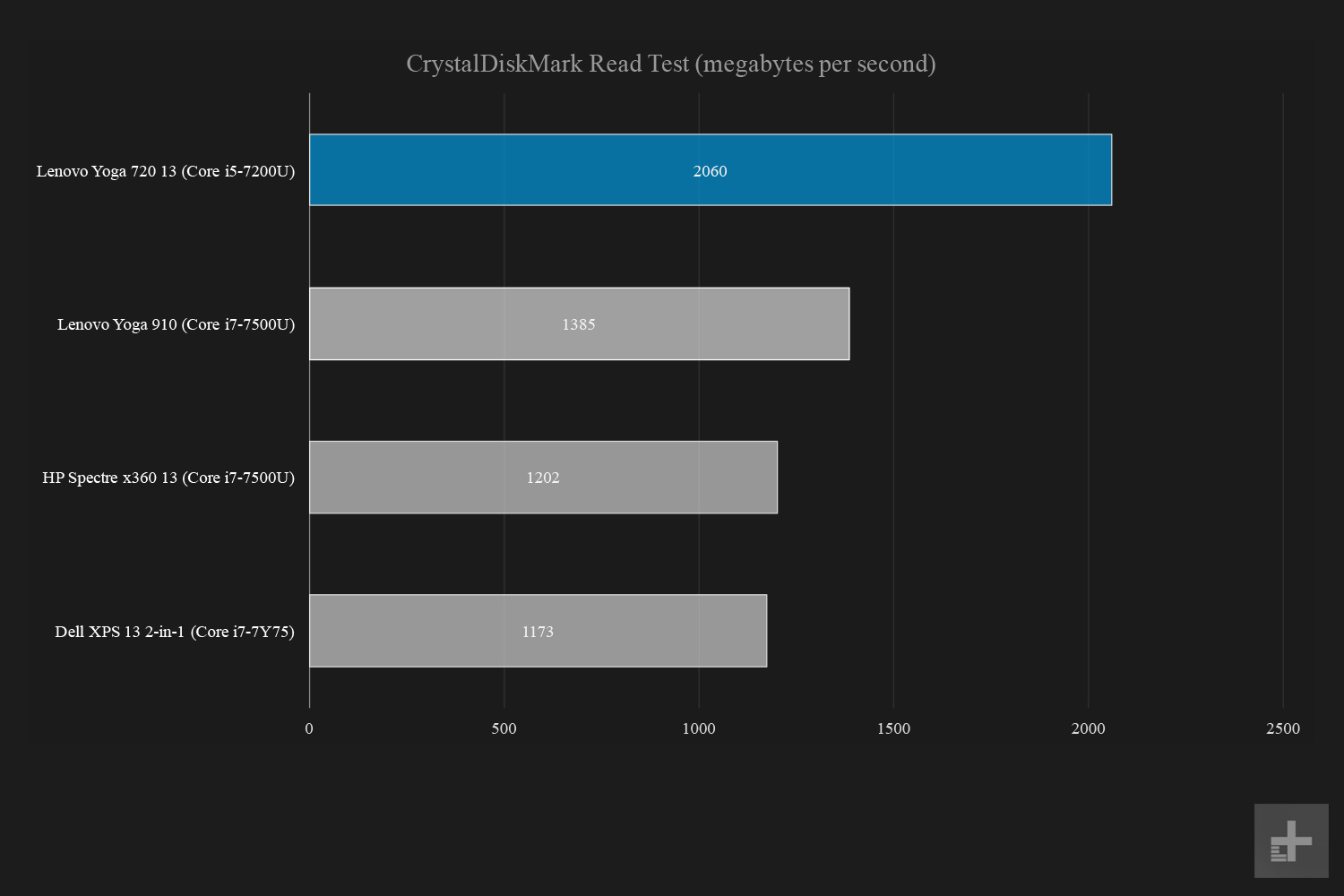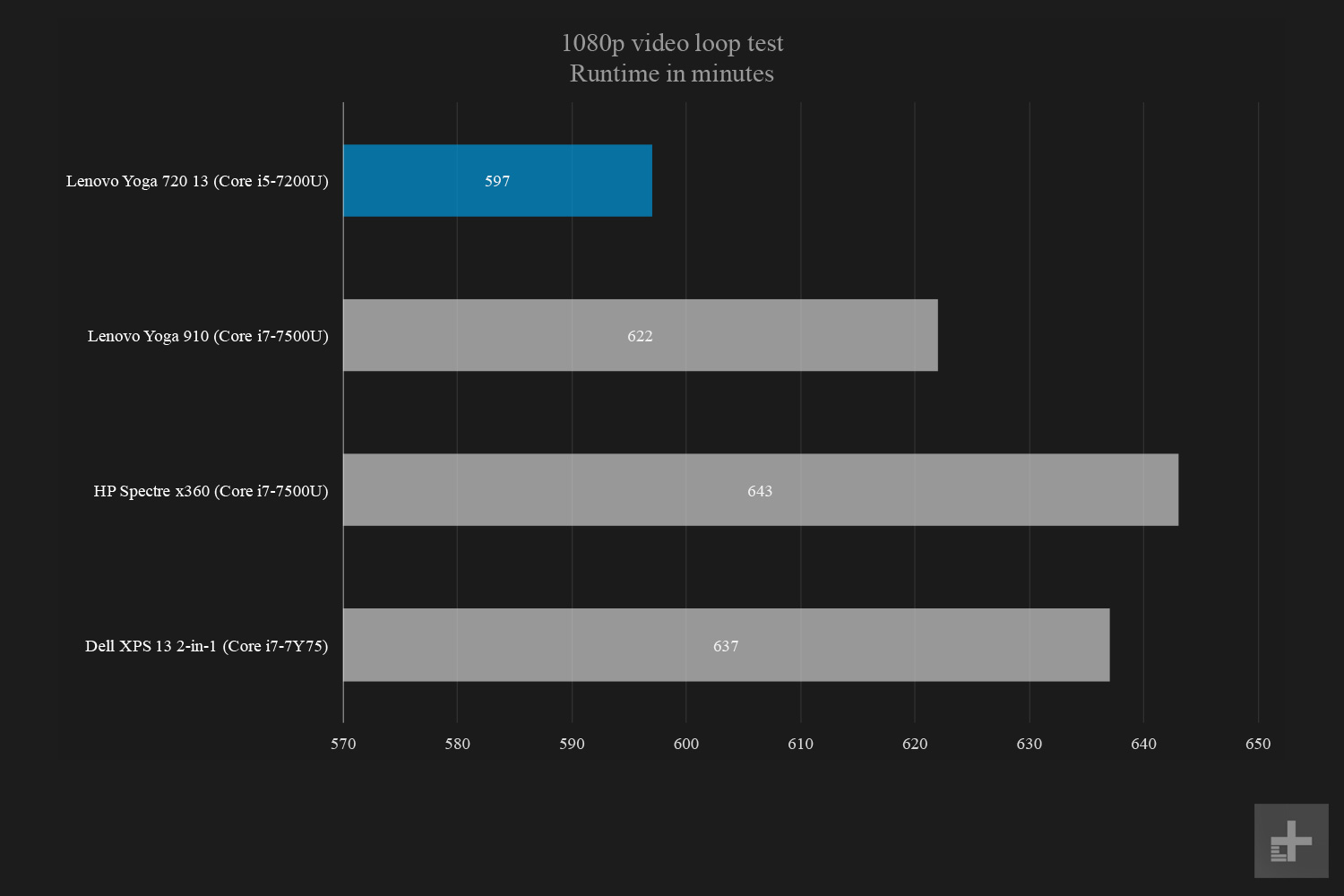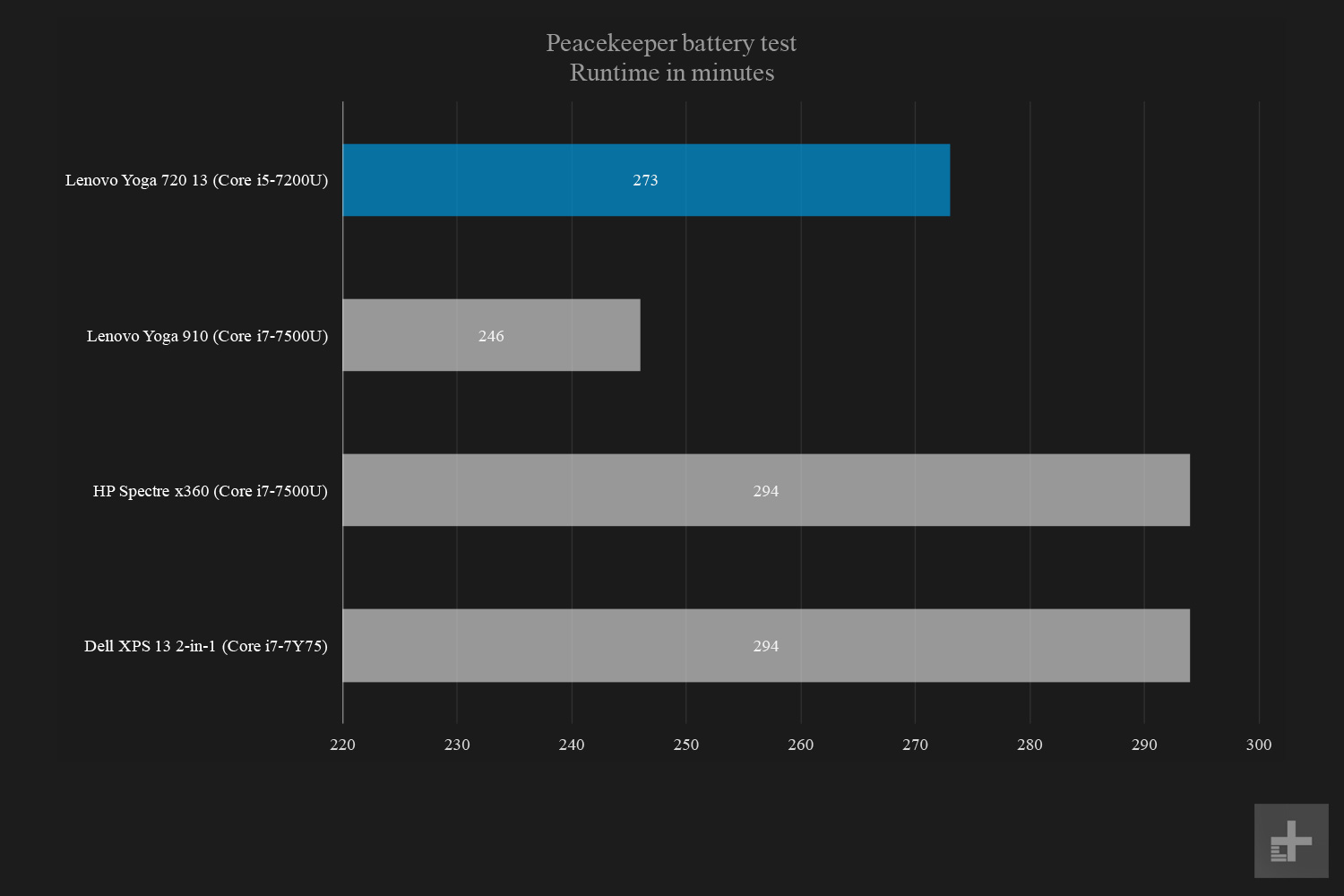
“Lenovo’s Yoga 720 13 offers solid performance, but is held back by an average display and mediocre battery life.”
- Good keyboard and better touchpad
- Outstanding storage performance
- Solid overall performance
- Decent value for the money
- Unremarkable display
- Mediocre battery life
- Fan is very loud at heavy loads
Update: We’ve updated the review to reflect Lenovo’s decision to only offer a Full HD display for the Yoga 720 13. The lack of a 4K UHD display option does not alter our rating for the notebook, but it’s worth keeping in mind as you’re choosing a new Windows 10 2-in-1.
The Windows 10 PC market has grown by leaps and bounds over the last few years, with a plethora of excellent options across incredibly diverse categories. Few categories have more great options than the 13.3-inch 360-degree convertible market, which today offers many outstanding machines from most of the major PC manufacturers.
Lenovo was at the leading edge of this category when it introduced the 13.9-inch version of its excellent Yoga 910 Windows 10 2-in-1. Now, the company has released the Yoga 720 13, which joins 13.3-inch options like the HP Spectre x360 13 and the Dell XPS 13 2-in-1. The Yoga 700-Series is positioned as a more affordable alternative to Lenovo’s top-tier 900.
Having so many great options means that the competition is fierce, and certainly HP and Dell have excellent machines that are going to be hard to beat. The Lenovo Yoga 720 is a reasonably priced alternative, however, with a retail price of $980 as reviewed (currently on sale for $829), with seventh-generation Intel Core i5-7200U processor, 8GB of RAM, and a 256GB SSD.
Does Lenovo’s Yoga 720 13 have what it takes to do battle in this competitive market?
Solid build quality and understated design
The Yoga 720 13 is a well-built 2-in-1 with a severely understated design aesthetic. It’s an unassuming yet attractive machine that will look good in just about any environment, personal or professional, yet it won’t stand out. Depending on your preferences, that can be a good or a bad thing.
The Yoga’s chassis is all-metal, as typical for 2-in-1s in this price range, and its aluminum finish is smooth without feeling slippery. Its Platinum Silver color scheme covers the entire unit, with polished silver trim along the edges helping to outline the touchpad. As expected, the Yoga squeezes its display in between thin bezels to minimize the overall footprint, and Lenovo deserves kudos for putting the webcam above the display where it belongs.
The Yoga 720 13 is a well-built 2-in-1 with a severely understated design aesthetic.
One important component in any convertible 2-in-1 device is the hinge, which should allow the screen to rotate through its entire range while holding the screen firmly in the desired position. Although the Yoga 720 doesn’t have the elegant watchband hinge that Lenovo uses in the Yoga 910, its simpler hinge works just as well. The rotation is smooth and consistent, and the screen is held in place whether in clamshell, presentation, media, or tablet modes – better than most hinges, in fact.
The Yoga 720 feels solidly built, without any loose or creaky parts, and it’s not hard to carry around given its 0.6-inch thickness. It might be non-descript, but that’s not a bad thing when you consider Lenovo’s focus on quality design and manufacturing.
Of course, 13-inch 2-in-1s are meant to be used as tablets, and the Yoga 720 succeeds at being comfortable to hold and use when the screen is wrapped all the way around. The usual 360-degree convertible caveats apply, such as the exposed keyboard and touchpad that feel odd at first, but the more you use the machine, the more natural it feels. The Yoga 720 does suffer a little from lacking hardware volume buttons, which means you’ll be reaching for the on-screen controls if you need to quiet things down.
A solid set of input options
Lenovo makes good keyboards, and the Yoga 720 is no exception. The keys have a light, springy action that requires a comfortable amount of force to engage. The travel is a little short, however, and a subtle bottoming action slightly spoils the experience. Still, it’s a good keyboard and will please most users. In addition, two levels of keyboard backlighting are available, which light the lettering nicely without significant leakage to distract in dimly-lit environments.
The Yoga 720 has limited connectivity, with a stronger emphasis on the future than on the past.
The touchpad is large enough to be useful, and not too large to take up too much space. The surface is pleasant to use, with just the right amount of friction, and it allows for precise control. Lenovo further guarantees accuracy by adopting the superior Microsoft Precision Touchpad protocol, which seems to ensure smooth and responsive support for Windows 10’s built-in gestures.
Lenovo chose to include a fingerprint scanner for Windows Hello password-less login, rather than an infrared camera and facial recognition. That’s probably fine, because not all systems provide completely reliable Windows Hello support by scanning a user’s face. In our testing, we never had a problem logging in with our finger.
The Yoga 720 13 also supports the company’s Active Pen, with full Windows 10 Ink support. Lenovo did not ship a pen with our review unit, however, and so we were unable to give it a try. The Lenovo Active Capacity Pen retails for $40, but it’s often available at Amazon at a discounted price.
Not a lot of connectivity, but at least it’s future-proof
The Yoga 720 has limited connectivity, with a stronger emphasis on the future than on the past. Two USB Type-C connections are on the left side of the chassis, one of which supports Thunderbolt 3 for high-speed connectivity. Either port can be used to charge the notebook via the provided USB Type-C cable and AC adapter.
Otherwise, a single USB Type-A 3.0 port is on the right side of the chassis, and a 3.5mm headset jack is provided next to the USB Type-C ports. Lenovo opted not to equip the Yoga 720 with an SD card reader. Wireless connectivity includes Bluetooth 4.1 and 802.11ac Wi-Fi.
Display
Our review unit was equipped with a Full HD (1,920 x 1,080) resolution display. Lenovo’s product overview documentation lists a 4K UHD display, but the company has decided not to move forward with the higher-resolution option. If you’re accustomed to contemporary
In our objective tests, the Yoga 720’s display posted mostly mediocre results. The contrast was low at 600:1, compared to a minimum comparison score of 900:1 as posted by the HP Spectre x360 13. The Yoga’s AdobeRGB color gamut support was on the low side at 70 percent, as was its sRGB score of 91 percent. Color accuracy was also poor at 3.0, exceeded only by the Dell XPS 13 2-in-1. The color accuracy score measures the error of the display, so a lower result is better. The best laptops can reach a score of one, and sometimes lower.
Gamma was spot-on at 2.2, which is a positive, and brightness was 298 nits, which is an average score. Those results all correlate with the subjective experience in using the display. It’s a decent enough experience for the typical productivity work, but it’s not a dream display.
While the Yoga 720’s display would have been superior just a few years ago, it doesn’t measure up to today’s
Speakers
The Yoga 720 has two JBL-branded speakers located on the bottom of the chassis, which provide decent enough sound for the usual PC audio and watching video. Lenovo boasts Dolby Audio Premium support, and while we thought the sound was more than adequate, we’d nevertheless recommend plugging in some headphones for the best audio experience.
A solid performer that punches above its weight class
Our Yoga 720 13 review unit was equipped with a seventh-generation Intel Core i5-7200U processor, 8GB of
In terms of our objective benchmarks, the Yoga 720 with its Core i5 held its own against our comparison machines equipped with the theoretically more powerful Core i7. From the Geekbench benchmark to the more challenging Handbrake test of encoding a 420MB
One thing we didn’t like, though, were the fans. They can become surprisingly loud at heavy load. In addition, the heat is vented straight out of the back of the unit, directly underneath the display, so using the Yoga 720 in a lap can be uncomfortable.
Super-speedy storage is a plus
Lenovo equipped the Yoga 720 13 with one of the fastest NVMe M.2 SSDs around, the venerated Samsung PM961. Accordingly, the machine provides seriously fast read and write times that beat some more expensive competitors.
The Yoga 720 achieved class-leading storage performance using our standby CrystalDiskMark benchmark, hitting 2,060 megabytes per second read speeds, and 1,209MB/s write speeds. Simply put, it has excellent performance that demolishes every one of our comparison systems.
Kudos to Lenovo for choosing a great SSD.
Gaming
The 13.3-inch Windows 10 2-in-1 market isn’t intended to make gamers happy. In fact, there isn’t currently a machine in this segment that provides anything approaching real gaming performance – and that’s just fine, because gaming isn’t why people buy these machines.

The Lenovo Yoga 720 is no different, of course. It uses the same Intel HD 620 graphics that are usual for this class of machine, and it performs accordingly. It’s competitive with our comparison group, but that’s not saying much.
You can play solitaire on the Yoga 720, and maybe some older gaming titles if you dial down the settings. But modern 3D games are out of the question, unless watching slideshows is your idea of fun.
Thin and light, but battery life suffers
The Yoga 720 13 is a reasonably thin Windows 10 2-in-1 at 0.6 inches thick, but that’s still a little thicker than other similar machines such as the HP Spectre x360, and the Dell XPS 13 2-in-1, at .54 inches. Its 2.9-pound weight is about par for this class of machine, making the Yoga 720 as easy to carry around as its competition.
In terms of battery capacity, the Yoga 720 13 comes in at a modest 48 watt-hours. That’s short of the HP Spectre x360 13’s 57.8 watt-hour battery, but a bit larger than the XPS 13 2-in-1’s 46 watt-hour battery.
On our Peacekeeper benchmark, which is a rather demanding test, the Yoga 720 managed a merely respectable score, achieving four hours and 33 minutes on our Peacekeeper test. That’s behind both the Spectre x360 and the XPS 13 2-in-1, the latter of which uses a low-power Intel Core i7-7Y75 CPU. It’s ahead of the Lenovo Yoga 910, which had a 79 watt-hour larger battery, but was tested with a battery-draining
While the Yoga 720’s display would have been superior just a few years ago, it doesn’t measure up to today’s
On our moderate benchmark that loops through a series of live web pages, the Yoga 720 performed a bit worse. It managed to run for six hours and 35 minutes, which was barely ahead of the Yoga 910, but behind the XPS 13 2-in-1, and significantly less than the Spectre x360.
Our final test loops a video from local storage, and the Yoga 720 ran for nine hours and 57 minutes. That’s behind all the comparison machines, including the Yoga 910.
Given that our review Yoga 720 also used an Intel Core i5-7200U that should use less power than all but the XPS 13 2-in-1’s low-powered CPU, these results are mediocre. Lenovo’s decision to equip the Yoga 720 with a modest battery might cause issues for anyone who needs to work away from a plug for as long as possible.
Software
Our Yoga 720 was a Microsoft Signature Edition variant, meaning it enjoyed a limited load of extra software. Other than the usual Windows 10 first-party apps and games, the only additional software were two useful Lenovo utilities, and a Dolby utility for adjusting audio settings. Lenovo does preload its own App Companion utility that gives you the chance to load up your own extraneous software.
Warranty
As usual for consumer notebooks, the Yoga 720 comes with a one-year parts and labor warranty.
Our Take
The Lenovo Yoga 720 13 is a solid Windows 10 2-in-1. It performs admirably, it’s built well, and it has a good keyboard and touchpad. Its battery life is sub-par, however, and the display could be better. It might be priced aggressively, but it needs to be, as it falls behind competitors in key areas.
Is there a better alternative?
The 13.3-inch Windows 10 2-in-1 market is full of great alternatives, but the key players in that space are the HP Spectre x360 13 and the Dell XPS 13 2-in-1. Each is available with seventh-generation Intel Core processors, each is as thin and light as the Lenovo 720, and each has a Full HD display option.
The Yoga 720 provides a lower cost of entry. As configured, with Core i5-7200U processor, 8GB of
The Yoga 720 and Spectre x360 are closer in price with a more robust configuration, namely an Intel Core i7-7500U, 16GB
In terms of performance, all the machines perform similarly enough that the typical productivity user won’t be able to tell the difference between them. Where the Yoga 720 falls behind is in battery life and display quality, and the lack of a
How long will it last?
The Yoga 720 has up-to-date components, including a super-fast SSD, and a seventh-generation Intel Core processor. It also offers state-of-the-art USB Type-C ports, making it relatively future-proof. It’s therefore likely to last a long time, particularly for the productivity tasks that the typical user cares about — as long as you never need a
Should you buy it?
If you’re looking for the most affordable 13.3-inch Windows 10 2-in-1 you can find that’s still dipping a toe in the premium segment, then the Yoga 720 13 is a good option. If you’re willing to spend just a bit more, however, competitor systems make this Lenovo look less appealing.
Editors' Recommendations
- 9 best 2-in-1 laptops in 2024: tested and reviewed
- Best HP laptop deals: Get a 17-inch workhorse for $270 and more
- 9 best laptops of 2024: tested and reviewed
- The best laptops for kids, tested and selected by experts
- The best Lenovo laptops for 2023: ThinkPad, Yoga, and more






